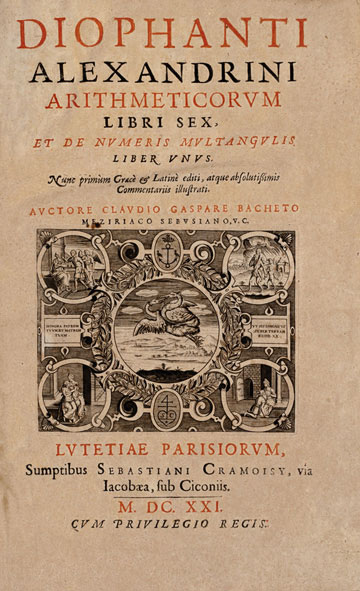
Diophantos of Alexandria – Title page of the 1621 edition of Diophantus’ Arithmetica, translated into Latin by Claude Gaspard Bachet de Méziriac.
Probably sometime between AD 201 and 215, Alexandrian Greek mathematician Diophantus of Alexandria was born. He is often referred to as the father of algebra. He is the author of a series of books called Arithmetica, many of which are now lost, which deal with solving algebraic equations. Diophantus was the first Greek mathematician who recognized fractions as numbers; thus he allowed positive rational numbers for the coefficients and solutions. The name “Diophantus” seems familiar? No wonder. While reading Claude Gaspard Bachet de Méziriac‘s edition of Diophantus‘ Arithmetica, famous mathematician Pierre de Fermat concluded that a certain equation considered by Diophantus had no solutions, and noted in the margin without elaboration that he had found “a truly marvelous proof of this proposition,” now referred to as Fermat’s Last Theorem.[1]
“If we arrive at an equation containing on each side the same term but with different coefficients, we must take equals from equals until we get one term equal to another term. But, if there are on one or on both sides negative terms, the deficiencies must be added on both bides until all the terms on both sides are positive. Then we must take equals from equals until one term is left on each side.”
– Diophantus of Alexandria, as quoted in [8]
The Life of Diophantus
As for many other scientists of antiquity only little is known about the life of Diophantus. He lived in Alexandria, Egypt, probably from between AD 200 and 214 to 284 or 298. Much of our knowledge of the life of Diophantus is derived from a 6th-century Greek anthology of number games and puzzles created by Metrodorus, a Greek grammarian and mathematician, who collected mathematical epigrams which appear in the Greek Anthology, a collection of poems that span the classical and Byzantine periods of Greek literature.
One of these epigrams is the famous epigram which reveals the age of Diophantus:
‘Here lies Diophantus,’ the wonder behold.
Through art algebraic, the stone tells how old:
‘God gave him his boyhood one-sixth of his life,
One twelfth more as youth while whiskers grew rife;
And then yet one-seventh ere marriage begun;
In five years there came a bouncing new son.
Alas, the dear child of master and sage
After attaining half the measure of his father’s life chill fate took him.
After consoling his fate by the science of numbers for four years, he ended his life.’
This can easily be transformed into the equation x = x/6 + x/12 + x/7 + 5 + x/2 + 4 that can be resolved to x=84. So he married at the age of 26 and had a son who died at the age of 42, four years before Diophantus himself died aged 84.[2] However, the age of 84 years for Diophantus nowhere else is confirmed.
The Arithmetica
The Arithmetica is the major work of Diophantus and the most prominent work on algebra in Greek mathematics. It is a collection of 130 problems giving numerical solutions of determinate equations (those with a unique solution), and indeterminate equations. The method for solving the latter is now known as Diophantine analysis. Only six of the original 13 books were thought to have survived and it was also thought that the others must have been lost quite soon after they were written.[2]
How to use Symbols
In the Arithmetica after some generalities about numbers, Diophantus first explains his symbolism: he uses symbols for the unknown (corresponding to our x) and its powers, positive or negative, as well as for some arithmetic operations—most of these symbols are clearly scribal abbreviations. This is the first and only occurrence of algebraic symbolism before the 15th century.[3] His style of algebra is known as the ‘syncopated’ style of algebraic writing, in which he represented polynomials as one unknown. Before Diophantus’s use of symbolism equations were written out completely.[4]
Linear and Quadratic Equations
The work considers the solution of many problems concerning linear and quadratic equations, but considers only positive rational solutions to these problems. Equations which would lead to solutions which are negative or irrational square roots, Diophantus considers as useless. To give one specific example, he calls the equation 4 = 4x + 20 ‘absurd’ because it would lead to a meaningless answer. In other words how could a problem lead to the solution -4 books? There is no evidence to suggest that Diophantus realized that a quadratic equation could have two solutions.[2]
Arithmetica and Beyond
In Book 3 of Arithmetica, Diophantus solves problems of finding values which make two linear expressions simultaneously into squares or cubes. In book 4, he finds rational powers between given numbers. He also noticed that numbers of the form 4n + 3 cannot be the sum of two squares. Diophantus also appears to know that every number can be written as the sum of four squares. If he did know this result (in the sense of having proved it as opposed to merely conjectured it), his doing so would be truly remarkable: even Fermat, who stated the result, failed to provide a proof of it and it was not settled until Joseph Louis Lagrange [5] proved it using results due to Leonhard Euler.[6]
The Psorims
Diophantus himself refers to another work which consists of a collection of lemmas called The Porisms but this book is entirely lost. We do know three lemmas contained in The Porisms since Diophantus refers to them in the Arithmetica.[2] Diophantus is also known to have written on polygonal numbers, i.e. a number represented as dots or pebbles arranged in the shape of a regular polygon, a topic of great interest to Pythagoras and Pythagoreans. Fragments of a book dealing with polygonal numbers are extant.
European Legacy
European mathematicians did not learn of the gems in Diophantus’s Arithmetica until Regiomontanus wrote in 1463:
“No one has yet translated from the Greek into Latin the thirteen Books of Diophantus, in which the very flower of the whole of arithmetic lies hid…”[2], Regiomontanus, Oratio habita Patavii in praelectione Alfragani
Diophantus’ work has had a large influence in history. Editions of Arithmetica exerted a profound influence on the development of algebra in Europe in the late sixteenth and through the 17th and 18th centuries. Diophantus and his works have also influenced Arab mathematics and were of great fame among Arab mathematicians.
Angela Stamilio, Diophantus, [10]
Refenences and Further Reading:
- [1] Pierre de Fermat and his Last Problem, SciHi blog.
- [2] O’Connor, John J.; Robertson, Edmund F., “Diophantus“, MacTutor History of Mathematics archive, University of St Andrews.
- [3] Diophantus of Alexandria, Greek Mathematician, in Britannica Online
- [4] Diophantus, at Famous Mathematicians
- [5] Joseph-Louis Lagrange and the Celestial Mechanics, SciHi Blog
- [6] Read Euler, he is the Master of us all…, SciHi Blog
- [7] Diophantus’s Riddle Diophantus’ epitaph, by E. Weisstein
- [8] Norbert Schappacher (2005). Diophantus of Alexandria : a Text and its History
- [9] Thomas Little Heath, Diophantos of Alexandria: A Study in the History of Greek Algebra (1885)
- [10] Angela Stamilio, Diophantus, MATH 455 Presentation 2 by Angela Stamilio @ youtube
- [11] Timeline of Ancient Greek Mathematicians, via DBpedia and Wikidata






You have written a great blog about Diophantus of Alexandria . Thanks for sharing such type of information. I want to know more about……….. Would you please give me any other resources so i could go in depth about it.